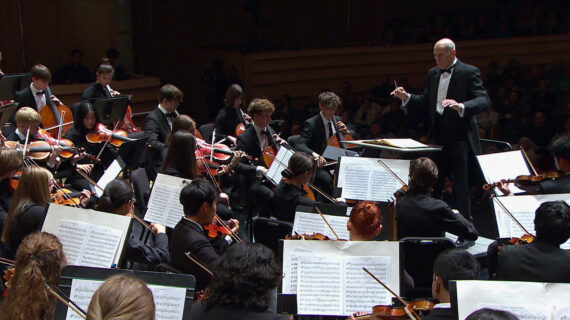Frederica Freyberg:
At this moment in time in Wisconsin, it’s a dead heat between Joe Biden and Donald Trump in the latest Marquette University Law School Poll, and that’s not all the survey shows. We turn to poll director, Charles Franklin, for more. Charles, thanks very much for being here.
Charles Franklin:
Good to be here.
Frederica Freyberg:
So I was going to talk about this a little bit later in our discussion, but the special council choosing not to charge President Joe Biden over his handling of classified documents also called him an elderly man with poor memory. Now, your poll found that 61% of respondents believe Biden too old to be president compared to 29% for Donald Trump. How do you think those numbers would look if you were in the field after this report?
Charles Franklin:
Well, I think it will only move further in the — too old to be president describes Biden very well. That 61% this time is already up from 55% in November. And so I do think that there’s not any evidence in those two months’ worth of polling that Biden is addressing the age issue. Now, the age issue has been with him for a long time. Donald Trump is only four years younger and yet far fewer people see him as too old. How does the campaign deal with this, given this report and these explicit examples and now, of course, everybody watching for every time Biden misspeaks.
Frederica Freyberg:
Meanwhile, when you were in the field, your poll showed a dead heat with Joe Biden at 49% and Donald Trump at 49% among registered voters, but third-party voters polled way higher — or candidates — polled way higher than normal with RFK, Jr. seeing 16%. Whose votes is he siphoning off?
Charles Franklin:
Well, it’s interesting. So when we just make it the head-to-head, it’s a dead tie. When we give five candidates as the choice, Kennedy at 16 is taking a little more actually from Republican voters than from Democratic voters. But Jill Stein, the Green Party candidate, takes 8% from Democrats and only 1% from Republicans. And Cornell West gets only a point or two from either party. So you’ve got to put that into perspective that in 2016, we had a recent high watermark for third party votes here in Wisconsin, and that was only 5 and a 1/2%. So the idea that we would see a third party vote totaling 20% or so seems unlikely come the fall. But it does reflect the dissatisfaction with both of the top party candidates. We found 18% said they had an unfavorable view of both Biden and of Trump. How do those 18% shake out over the year?
Frederica Freyberg:
There is another match-up that’s super interesting and kind of speaks to this and that is the Biden-Haley match-up. Nikky Haley in your poll getting 57% to Biden 41%. What does this say about both Biden and Trump and Haley?
Charles Franklin:
I think it’s an important indication that Biden and Trump both have serious disadvantages. And when you put them head-to-head, you come up with a tie, but when it’s Biden versus Haley, who really is still not very well known in the state, Biden’s liabilities stand out. In fact, his 41% against Haley is the same as his job approval number. And so that’s just a good example that a candidate without Trump’s baggage could at least hypothetically do much better to exploit Biden’s weaknesses, but just as Biden has this too old to be president, 53% say Trump committed illegal acts after the election in 2020. So there’s the flip side of who’s got real problems.
Frederica Freyberg:
So that might say something, too, about voter enthusiasm. In that regard, 49% of your respondents say they are very enthusiastic to vote compared to 70% in 2020.
Charles Franklin:
Yeah, it’s dramatically different and that 2020 number is from January 2020 as well. It’s not late in the campaign. It’s the same month. And also right before COVID hit, so it’s before the COVID effects, if any. You know, again, I see that both Biden and Trump are seen more unfavorably than favorably. Each of them has these difficulties. However on enthusiasm, those who are very enthusiastic go heavily for Donald Trump. It’s the less than very enthusiastic, somewhat, not to, not at all. Biden wins each of those groups very substantially as well. And yet despite that, they’re tied when you push people to who you’ll vote for. The challenge for the Democrats is how do you deal with those less enthusiastic people that like — that are disappointed with Biden but like Trump not much at all? Can you mobilize them and get them to the polls? Or are those exactly the people that may say, eh, not good enough, I’ll vote third-party this year. Nine months to go to settle that question.
Frederica Freyberg:
So as to Governor Tony Evers in Wisconsin coming back stateside, his approval is right side up with 51% approving of his job performance and 44% disapproving. That stacks up pretty well.
Charles Franklin:
It’s not bad at all. It’s down just slightly from November, but up a bit from the election in the fall of 2022. He’s doing pretty well. He’s generally been above water on that approval measure here in the state.
Frederica Freyberg:
Which seems interesting to me given how much kind of discord there is.
Charles Franklin:
Well, there’s still plenty of discord. There are a couple of things in this poll. From November to January, the percent of people saying the state’s headed in the right direction has bumped up significantly, and the percent of people saying the national economy is getting better or is not as bad as they saw it in November, that’s also about 10 points higher than November. And finally, Wisconsin’s economy is seen as even better than the national economy.
Frederica Freyberg:
Good news for us. Charles Franklin, thanks very much.
Charles Franklin:
Thank you.
Search Episodes
Related Stories from PBS Wisconsin's Blog

Donate to sign up. Activate and sign in to Passport. It's that easy to help PBS Wisconsin serve your community through media that educates, inspires, and entertains.
Make your membership gift today
Only for new users: Activate Passport using your code or email address
Already a member?
Look up my account
Need some help? Go to FAQ or visit PBS Passport Help
Need help accessing PBS Wisconsin anywhere?

Online Access | Platform & Device Access | Cable or Satellite Access | Over-The-Air Access
Visit Access Guide
Need help accessing PBS Wisconsin anywhere?

Visit Our
Live TV Access Guide
Online AccessPlatform & Device Access
Cable or Satellite Access
Over-The-Air Access
Visit Access Guide
 Passport
Passport








Follow Us